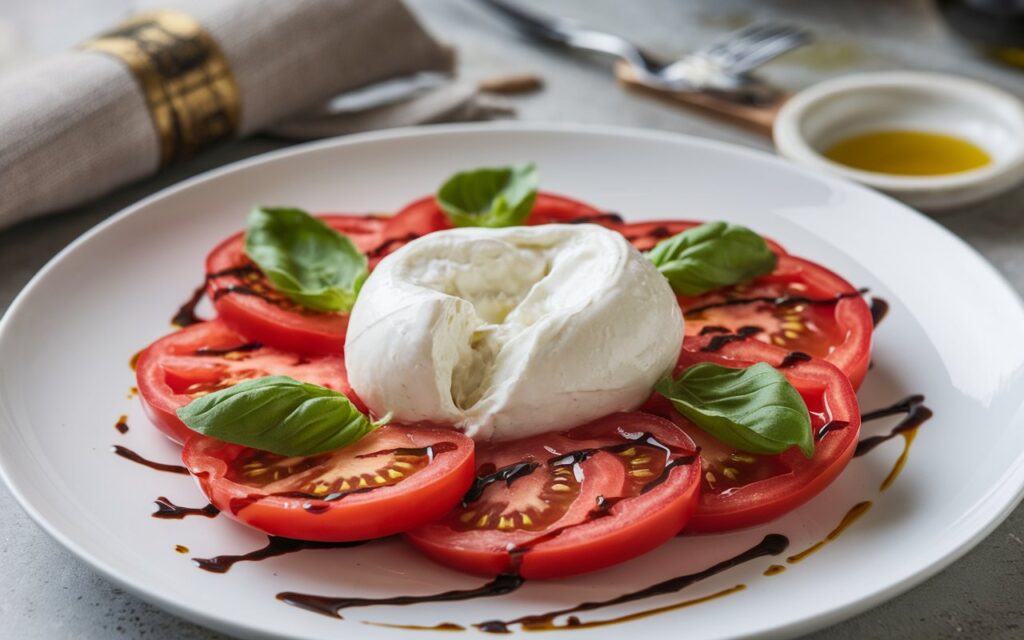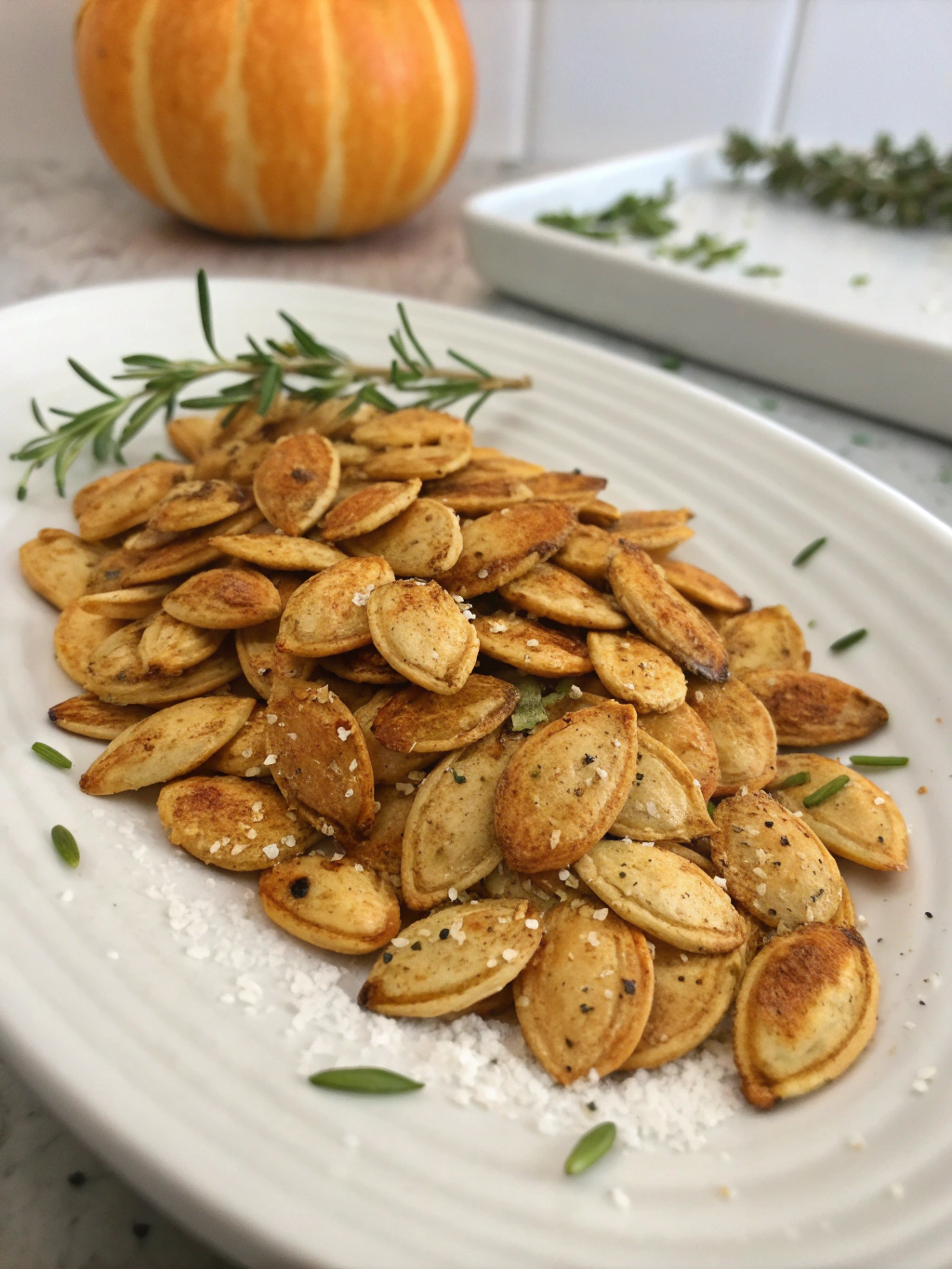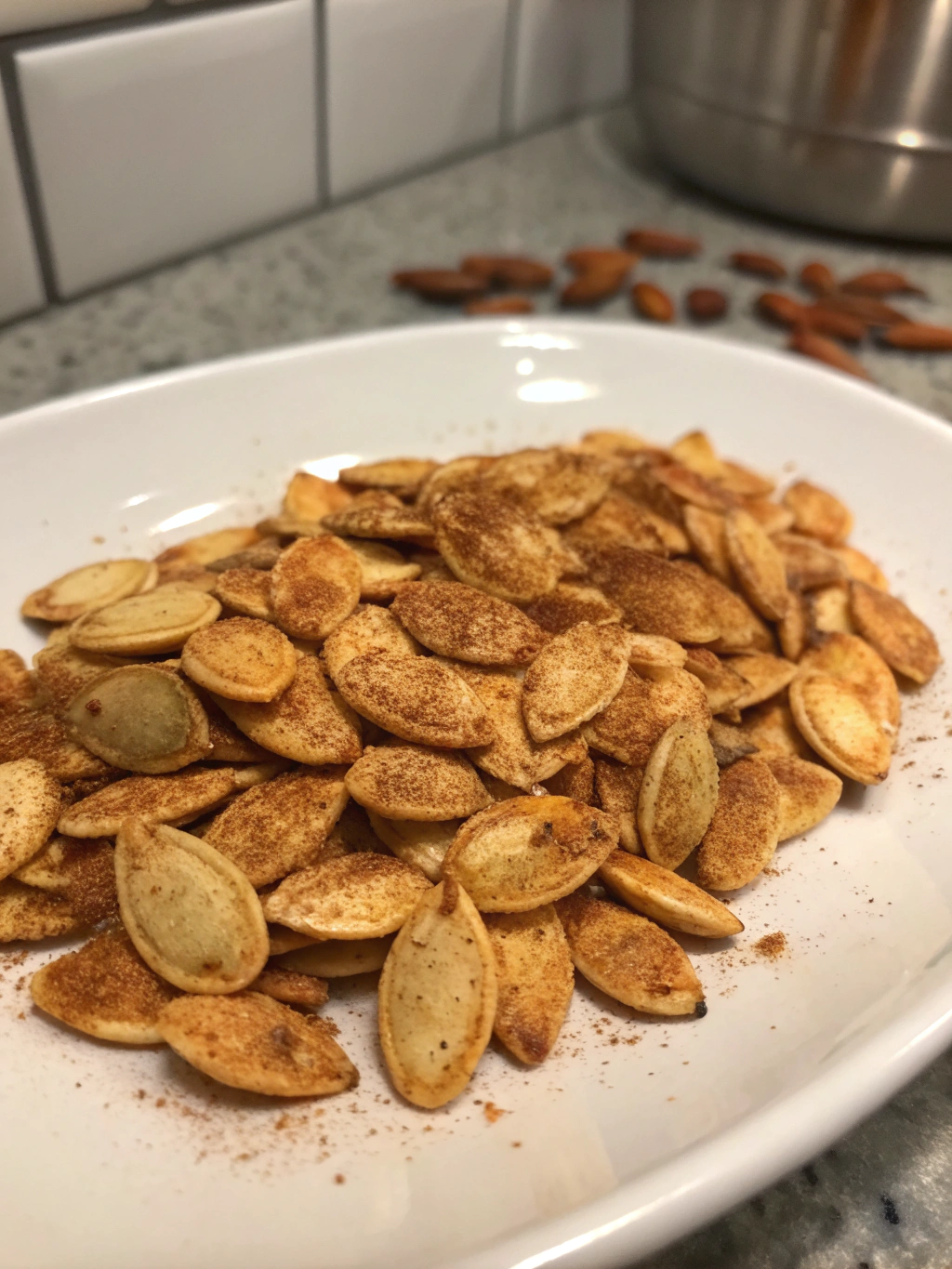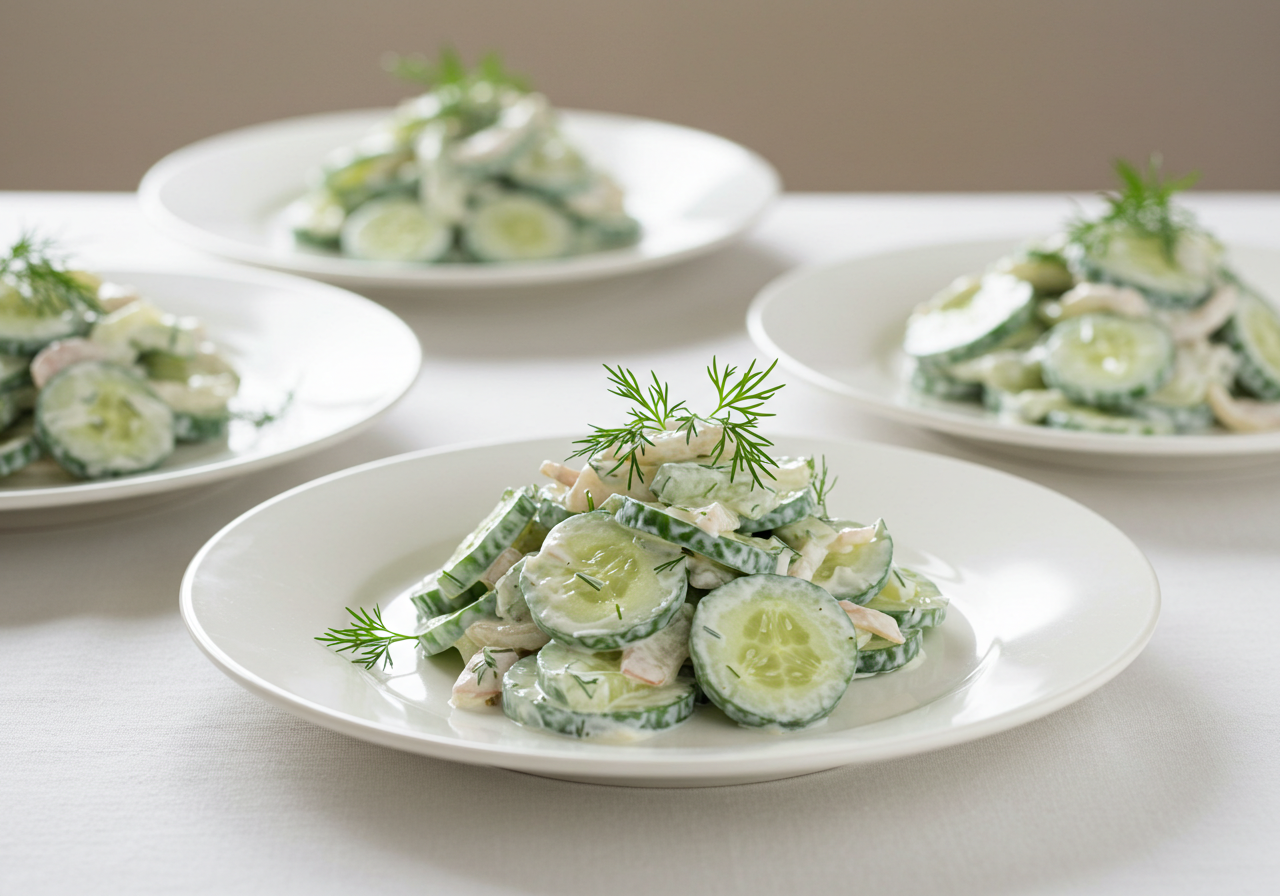Burrata Caprese is a culinary delight that brings together the luxurious creaminess of burrata cheese with the vibrant freshness of classic Caprese ingredients. A true testament to the beauty of simplicity, this dish has captured the hearts of food lovers worldwide.
What is Burrata Caprese?
Origins of Burrata and its Pairing with Caprese Ingredients
Burrata, a traditional Italian cheese, originated in the Apulia region. Crafted from mozzarella and cream, it is characterized by a delicate outer shell that encases a soft, creamy center. When paired with Caprese essentials such as ripe tomatoes, fresh basil, and a drizzle of olive oil, burrata elevates this classic combination to new heights.
What Makes This Dish Special?
Burrata Caprese is not just a dish; it’s an experience. The balance of textures—smooth and creamy burrata against juicy tomatoes—and the interplay of flavors create a harmonious and satisfying bite. The addition of high-quality olive oil and balsamic glaze enhances its rich and refreshing taste.
Why is it a Popular Dish?
Simplicity Combined with Gourmet Appeal
One of the reasons Burrata Caprese is beloved is its elegant simplicity. The dish uses just a handful of fresh, high-quality ingredients, yet it exudes a sophisticated, gourmet appeal that can impress any palate.
Versatility in Serving Occasions
From casual summer picnics to upscale dinner parties, Burrata Caprese shines in any setting. Its vibrant presentation and universally loved flavors make it a versatile choice for appetizers, light lunches, or even as a main course when paired with crusty bread or pasta.
Ingredients of Burrata Caprese
Core Ingredients
Burrata Cheese: Characteristics and Flavor Profile
Burrata is the heart of this dish, known for its luxurious texture and mild, creamy flavor. Made from mozzarella and cream, it has a soft outer shell and an oozy interior that melts in your mouth. Its delicate taste pairs beautifully with the bright and tangy flavors of the other ingredients, making it an essential component of Burrata Caprese.
Fresh Tomatoes: Choosing the Best Variety
Tomatoes are the foundation of the dish’s freshness. Opt for ripe, juicy varieties like heirloom, Roma, or cherry tomatoes, as they provide the perfect balance of sweetness and acidity. Their vibrant colors also enhance the visual appeal of the dish.
Basil Leaves: The Herb That Ties It All Together
Fresh basil leaves are the aromatic cornerstone of Burrata Caprese. Their fragrant, slightly sweet flavor adds a lively contrast to the creaminess of the burrata and the tang of the tomatoes, completing the dish’s harmonious flavor profile.
Optional Additions
Balsamic Glaze or Vinegar
A drizzle of balsamic glaze or a splash of high-quality balsamic vinegar adds a touch of sweetness and tanginess, enhancing the overall depth of flavor in the dish.
Extra Virgin Olive Oil: Choosing Quality Oil for the Best Flavor
Extra virgin olive oil is an indispensable addition. Look for a cold-pressed, high-quality oil with a rich, fruity aroma. Its smooth, nutty flavor complements the freshness of the tomatoes and basil while enhancing the burrata’s creaminess.
Sea Salt and Pepper: Enhancing the Dish
A sprinkle of flaky sea salt and freshly cracked black pepper brings out the natural flavors of the ingredients. These simple seasonings are the finishing touch that ties everything together, elevating the dish to gourmet status.
Step-by-Step Guide to Making Burrata Caprese
Preparation of Ingredients
Washing and Slicing Tomatoes
Start by thoroughly washing the tomatoes under cool running water to remove any dirt or residue. If using larger varieties like heirloom or Roma tomatoes, slice them into even rounds for a visually appealing presentation. For cherry tomatoes, simply halve them to maintain their shape and freshness.
Proper Handling and Presentation of Burrata
Carefully remove the burrata from its packaging to preserve its delicate structure. Place it on a plate and allow it to come to room temperature for the best flavor and texture. Avoid cutting it until serving to keep its creamy interior intact, creating a delightful surprise when broken open.
Arranging the Dish
Layering for Aesthetics and Flavor
On a serving plate or platter, arrange the sliced tomatoes in a circular or layered pattern. Tuck fresh basil leaves between the tomato slices for a burst of color and fragrance. Place the burrata in the center or to one side, depending on your desired presentation style.
Drizzling Balsamic Glaze or Olive Oil for the Finishing Touch
Drizzle a generous amount of high-quality extra virgin olive oil over the tomatoes and burrata. If desired, add a light drizzle of balsamic glaze or a few drops of balsamic vinegar for a tangy sweetness. Finish with a sprinkle of flaky sea salt and freshly cracked black pepper to enhance the flavors.
Tips for the Best Burrata Caprese
Picking the Right Ingredients
How to Select Fresh and High-Quality Burrata and Produce
- Burrata Cheese: Look for burrata that is fresh and has a smooth, shiny exterior. When pressed lightly, it should feel soft but not mushy. Check the expiration date and, if possible, purchase from a local cheese shop or a reputable source for the best quality.
- Tomatoes: Choose tomatoes that are firm yet ripe, with a deep, vibrant color. Heirloom tomatoes are excellent for their variety of flavors and hues, while Roma or cherry tomatoes are great for a consistent texture. Avoid overly soft or bruised tomatoes.
- Basil: Fresh basil is key for this dish. Select leaves that are bright green, free of dark spots, and have a strong, aromatic fragrance. Use immediately for the freshest flavor.
- Olive Oil and Balsamic Glaze: Invest in high-quality extra virgin olive oil with a robust flavor profile. For balsamic glaze, ensure it has a good balance of sweetness and acidity without being overly thick or artificial.
Achieving the Perfect Balance
Balancing Creaminess, Acidity, and Freshness
- Creaminess: The burrata’s creamy texture is the star of the dish, so ensure it remains the focal point by pairing it with complementary ingredients rather than overpowering flavors.
- Acidity: Tomatoes and balsamic glaze or vinegar provide a pleasant tanginess. Use these elements judiciously to cut through the richness of the burrata without overwhelming it.
- Freshness: The basil and olive oil contribute brightness and herbaceous notes that tie the dish together. Make sure they are used sparingly yet strategically to highlight, not mask, the dish’s natural flavors.
By balancing these elements, you’ll create a harmonious Burrata Caprese that delights both the palate and the eyes.
Variations of Burrata Caprese
Seasonal Variations
Using Heirloom Tomatoes or Seasonal Fruits
- Heirloom Tomatoes: Enhance the dish with heirloom tomatoes of varying colors and flavors, adding a stunning visual and flavor diversity to your plate.
- Seasonal Fruits: For a unique twist, substitute or complement tomatoes with fruits like peaches, figs, or watermelon. These options bring a subtle sweetness that pairs beautifully with the creamy burrata and fresh basil.
Creative Twists
Adding Arugula, Prosciutto, or Roasted Vegetables
- Arugula: Incorporate a handful of peppery arugula leaves to add a refreshing contrast and extra texture.
- Prosciutto: Drape thin slices of prosciutto over the dish for a salty, savory addition that complements the creamy burrata.
- Roasted Vegetables: Add depth by including roasted vegetables such as zucchini, bell peppers, or eggplant, creating a warm and hearty variation.
Vegan and Dairy-Free Alternatives
Substitutes for Burrata Cheese for a Plant-Based Version
- Vegan Cheese: Use a plant-based mozzarella or cashew cream cheese to mimic the creamy texture of burrata.
- Avocado: Slices of ripe avocado can also provide a creamy, satisfying texture that pairs well with tomatoes and basil for a vegan-friendly option.
Pairing Burrata Caprese with Other Foods
Wine Pairings
Best Wines to Complement the Flavors
- White Wines: Opt for crisp, light-bodied whites like Sauvignon Blanc or Pinot Grigio to enhance the freshness of the dish.
- Rosé: A dry rosé provides a perfect middle ground, balancing acidity with a hint of fruitiness.
- Red Wines: If you prefer reds, choose a light-bodied variety like Pinot Noir or a young Chianti to avoid overpowering the delicate flavors of the dish.
Serving Suggestions
Serving with Crusty Bread, Pasta, or as a Standalone Appetizer
- Crusty Bread: Pair with freshly baked ciabatta or a baguette for a satisfying way to scoop up the burrata and juices from the tomatoes.
- Pasta: Serve Burrata Caprese as a topping for warm pasta or alongside a cold pasta salad for a heartier meal.
- Standalone Appetizer: Present it as a centerpiece appetizer for gatherings, letting its simplicity and elegance shine.
Nutritional Benefits of Burrata Caprese
Health Benefits of Burrata
Protein and Calcium Content
Burrata cheese is a good source of protein, essential for muscle repair and overall body maintenance. Additionally, it contains calcium, which supports strong bones and teeth, making it a nutritious indulgence when consumed in moderation. Its creamy texture satisfies cravings while delivering these vital nutrients.
Fresh Ingredients and Their Benefits
Antioxidants from Tomatoes and Basil
- Tomatoes: Rich in antioxidants like lycopene, tomatoes contribute to heart health and provide protection against certain chronic diseases. They are also a great source of vitamin C, which boosts immunity.
- Basil: This aromatic herb is packed with essential oils and antioxidants, including eugenol, which has anti-inflammatory properties. Basil also provides vitamins A and K, promoting eye health and blood clotting.
History and Cultural Significance
Origin of Burrata Cheese
Historical Roots in Italian Cuisine
Burrata originated in the Apulia (Puglia) region of Italy in the early 20th century. It was created as a way to utilize leftover mozzarella curds, wrapped in a solid mozzarella shell and filled with cream. Over time, it became a symbol of Italian culinary innovation, celebrated for its luxurious texture and flavor.
Evolution of Caprese Salad
How Burrata Has Been Incorporated into the Traditional Caprese Recipe
The traditional Caprese salad, with its simple combination of mozzarella, tomatoes, and basil, is said to have been inspired by the colors of the Italian flag. The addition of burrata to this classic dish is a modern twist, elevating its texture and richness. This adaptation has grown in popularity as food enthusiasts seek indulgent yet refreshing variations of beloved recipes.

Conclusion
Burrata Caprese is a masterpiece of simplicity, showcasing the beauty of fresh, high-quality ingredients. Its creamy burrata, juicy tomatoes, fragrant basil, and optional drizzles of olive oil and balsamic glaze come together to create a dish that is as visually stunning as it is delicious.
The versatility of Burrata Caprese makes it a favorite for a variety of occasions, from casual gatherings to elegant dinner parties. Whether you stick to the classic recipe or experiment with seasonal variations, creative twists, or plant-based alternatives, this dish promises to delight every palate.
Embrace the art of simplicity and let the natural flavors shine—Burrata Caprese is not just a dish; it’s an invitation to savor and celebrate the joy of good food.
To enrich your exploration of Burrata Caprese, consider pairing it with dishes or techniques from similar culinary traditions for a well-rounded meal. For example, you might find inspiration in recipes like Creamy Avocado Salad: A Nutritious Delight, which complements the freshness and simplicity of Caprese with its creamy textures and vibrant flavors. Additionally, for a heartier meal, explore the delicious pairing of burrata with ideas from Ricotta Pizza, showcasing how creamy cheeses enhance rustic Italian dishes. If you’re experimenting with seasonal variations, consider ideas from Cantaloupe and Prosciutto to elevate your Burrata Caprese with sweet and savory contrasts.
Frequently Asked Questions about Burrata Caprese
Can I Store Burrata Caprese?
Tips for Storage and Freshness
While Burrata Caprese is best enjoyed fresh, you can store any leftovers in an airtight container in the refrigerator for up to one day. Keep the burrata cheese separate from the tomatoes and dressing to maintain its texture and flavor. Before serving, allow the burrata to come to room temperature to restore its creamy consistency.
What Can I Use Instead of Burrata?
Alternative Cheese Options
If burrata isn’t available, you can substitute it with fresh mozzarella for a more traditional Caprese experience. Other creamy cheeses like ricotta, mascarpone, or even a soft goat cheese can also work well, adding their own unique flavor profiles to the dish.
Is Burrata Caprese Keto-Friendly?
Discussing Its Compatibility with Low-Carb Diets
Yes, Burrata Caprese can be keto-friendly! The dish is naturally low in carbohydrates and high in healthy fats from the burrata and olive oil. To keep it fully keto-compliant, avoid adding balsamic glaze, as it may contain added sugars, and opt for balsamic vinegar or other low-carb dressings instead.








